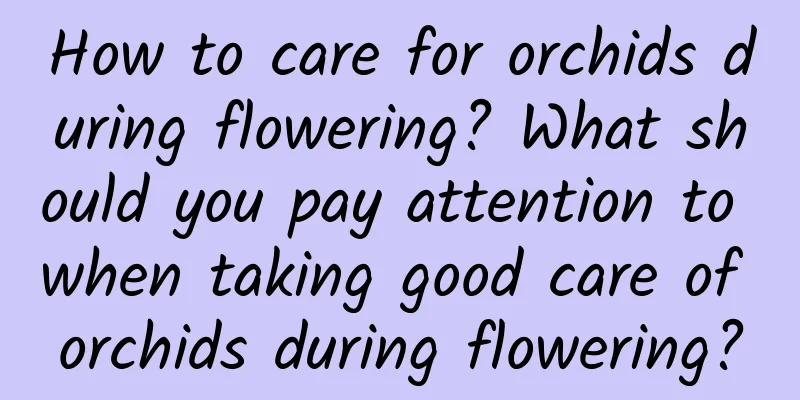How to care for orchids during flowering? What should you pay attention to when taking good care of orchids during flowering?

|
After the orchid buds appear, water it appropriately to keep the pot soil moist. Be careful not to have water in the buds. After the flowers bloom, reduce the amount of watering and water when the soil is dry and wet. Today we will specifically introduce the key points of orchid maintenance during the flowering period. WateringAfter the orchid grows flower buds, water it appropriately to keep the pot soil moist. If there is a lack of water, the flower stalk will rise, so water it when the soil is dry and when it is wet. When watering, be careful not to sprinkle water into the flower buds, otherwise it will easily cause the flower buds to rot. After the orchid blooms, water it less. Excessive watering will easily cause the outer three petals of the flower to elongate, affecting the beauty of the plant. Reasonable fertilizationIf the orchid is provided with sufficient nutrients before it buds, then there is no need to fertilize it again after the buds open. The nutrients already in the plant can prompt it to bloom. However, if the nutrients given at ordinary times are insufficient, it is necessary to add fertilizer appropriately after the flower buds grow. Potassium dihydrogen phosphate solution can be applied and the solution can be diluted before spraying. Reasonable fertilization can promote flowering and prolong the flowering period of orchids . Light adaptationOrchids are semi-shade plants . After the orchids grow flower buds, move the plants to a place with sufficient scattered light. Allowing orchids to have sufficient light will help them bloom more beautiful and colorful flowers. After the flower buds bloom, move the plants to a cool place and avoid direct sunlight, which will help prolong the flowering period. Timely bud thinningOrchids have a long flowering period. As the number of flower buds increases, the dead flowers and branches need to be cut off in time . This helps to ensure that the newly opened flowers have enough nutrients and the plants continue to bloom. Water and fertilizerOrchids consume more nutrients when they bloom, so be sure to fertilize them in time. Before the flower stalks grow out, you can give them some diluted cake fertilizer water every month . After flowering, use fertilizer once every half a month to make the flowers more beautiful. Pest and disease preventionBefore flowering, pay attention to reducing fertilization. Increasing the amount of fertilizer before flowering may increase the possibility of infection with pests and diseases. It is necessary to supplement fungicides in time to prevent infection and root rot of plants. Protect from rainAfter orchids have buds, they need to be protected from rain , as rain can easily cause petals to wither, which is not conducive to the growth of the plant. In windy and rainy weather, the plants must be moved indoors to avoid being exposed to rain. |
>>: How many days is the growing period of celery? How long does it take for celery to mature?
Recommend
Gardenia leaves turning yellow and buds falling off? If you grow it like this, it will be green and juicy, and the pot will be full of flowers in no time!
Is it difficult to grow gardenias? It’s too diffi...
Common diseases of Clivia
Common diseases Some common diseases of Clivia in...
How to grow jade tree
1. Breeding environment (1) Soil: Generally speak...
What medicinal materials are suitable for planting in Zhejiang? What precious Chinese medicines are mainly produced in Zhejiang?
Zhejiang has a subtropical monsoon climate, with ...
What plants can cure diseases?
1. Houttuynia cordata Plants can resist bacteria ...
What should I do if the leaves of azalea are dry and fall off when touched?
1. Shading If azalea is exposed to the sun for a ...
How can the gourd turn yellow? How can the gourd turn yellow quickly?
1. Conventional yellowing method 1. Sunlight: The...
How to grow white sandalwood cactus and make it bloom
Winter care of white sandalwood cactus It is very...
When watering flowers, water quickly flows out from the bottom of the flower pot (do you need to pour out the water at the bottom of the pot after watering the flowers)
A flower lover asked : Is it correct to water the...
How to grow lotus in water through the winter? Can lotus be grown in the north?
1. Wintering in the South In the south, the clima...
What vegetables are suitable to grow after Grain in Ear?
What vegetables are suitable to grow after Grain ...
How to trim lavender
When to prune lavender It is generally better to ...
How to cultivate Oncidium
Oncidium Growing Conditions Oncidium prefers a hu...
Why Gardenia Buds Don't Bloom
1. Causes and solutions 1. During the growth peri...
This little thing that every household has can save thousands of dollars a year by growing flowers
Layering It is not easy for woody flowers such as...









